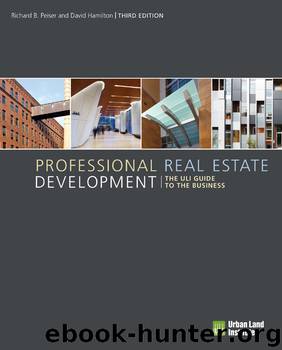Professional Real Estate Development by Richard B. Peiser

Author:Richard B. Peiser [Peiser, Richard B.; Hamilton, David]
Language: eng
Format: epub
ISBN: 978-0-87420-277-9
Publisher: Urban Land Institute
Published: 2012-07-31T16:00:00+00:00
Rappaport observes that the sponsors of one of the deals in which the New Boston Fund invested—Vincent G. Norton’s Schoolhouse at Lower Mills project—”could have taken the construction cost savings achieved and put it toward their equity contribution, or they could have reduced its basis to make it easier to carry. Instead, the developers used the savings to fund upgraded interior finishes and amenities.”53
In structuring joint ventures with investors, the priorities of payback and cash distributions are even more important than the final split of profits. As indicated in the previous examples, it is common for investors to receive back their investment before the developer shares in any profit. When both the investor and the developer have money invested in a project, the investor may receive, say, the first $100,000 as a priority payback before the developer receives the next $100,000 of cash flow. Priorities become a way of dealing with risk—the person who bears the most risk receives money back last. Risk is higher because, if a loss occurs, there may be no money left to pay back lower priorities.
Preferred returns are similar to interest on money invested in a savings account. The difference is that they are paid only if cash flow is available—like dividends—whereas interest must be paid currently whether cash flow from a project is available or not (if not, then the general partner must cover the interest from other sources or default on the loan). The basic concept behind preferred returns is that the investors will be paid back as a top priority at least the equivalent interest on their investments that they would earn in an interest-bearing account. Although many deals have no preferred returns, beginning developers are advised to include them because they make raising equity a little easier. Investors like the notion that they will receive back their initial equity plus a preferred return before the developer receives any profit. It is customary for the developer to receive a “development fee”—3 to 5 percent of total costs (sometimes excluding land) during construction to cover overhead. But any significant profit to the developer carries a lower priority than the investor’s return of capital and preferred return.
One of the simpler and more common deal structures has four priorities (similar to Harry Mow’s structure described above):
1. Investors receive a current preferred return.
2. Investors receive unpaid but accrued preferred returns.
3. Investors receive back their equity.
4. Investors and the developer split the remainder according to a profit split ranging from 80/20 (80 percent to the investors) to 50/50.
Download
This site does not store any files on its server. We only index and link to content provided by other sites. Please contact the content providers to delete copyright contents if any and email us, we'll remove relevant links or contents immediately.
Kathy Andrews Collection by Kathy Andrews(11767)
The remains of the day by Kazuo Ishiguro(8896)
Spare by Prince Harry The Duke of Sussex(5142)
Paper Towns by Green John(5141)
The Body: A Guide for Occupants by Bill Bryson(5033)
Industrial Automation from Scratch: A hands-on guide to using sensors, actuators, PLCs, HMIs, and SCADA to automate industrial processes by Olushola Akande(5027)
Machine Learning at Scale with H2O by Gregory Keys | David Whiting(4262)
Be in a Treehouse by Pete Nelson(3999)
Never by Ken Follett(3885)
Harry Potter and the Goblet Of Fire by J.K. Rowling(3810)
Goodbye Paradise(3767)
Into Thin Air by Jon Krakauer(3350)
The Remains of the Day by Kazuo Ishiguro(3349)
Fairy Tale by Stephen King(3310)
The Cellar by Natasha Preston(3299)
The Genius of Japanese Carpentry by Azby Brown(3256)
120 Days of Sodom by Marquis de Sade(3229)
The Man Who Died Twice by Richard Osman(3042)
Drawing Shortcuts: Developing Quick Drawing Skills Using Today's Technology by Leggitt Jim(3040)
